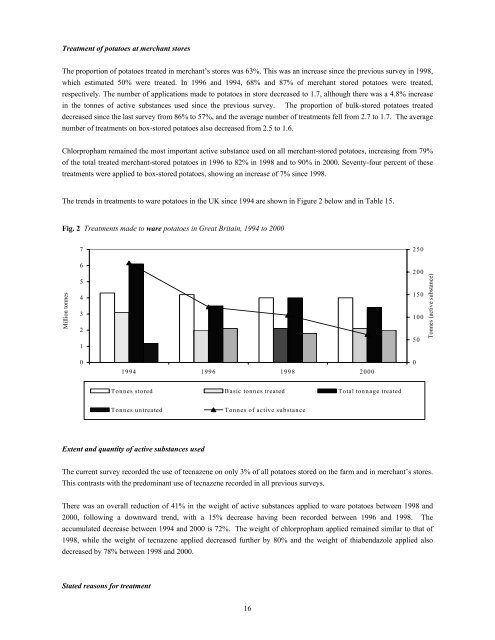Potato Stores in Great Britain - The Food and Environment Research ...
Potato Stores in Great Britain - The Food and Environment Research ...
Potato Stores in Great Britain - The Food and Environment Research ...
You also want an ePaper? Increase the reach of your titles
YUMPU automatically turns print PDFs into web optimized ePapers that Google loves.
Treatment of potatoes at merchant stores<br />
<strong>The</strong> proportion of potatoes treated <strong>in</strong> merchant’s stores was 63%. This was an <strong>in</strong>crease s<strong>in</strong>ce the previous survey <strong>in</strong> 1998,<br />
which estimated 50% were treated. In 1996 <strong>and</strong> 1994, 68% <strong>and</strong> 87% of merchant stored potatoes were treated,<br />
respectively. <strong>The</strong> number of applications made to potatoes <strong>in</strong> store decreased to 1.7, although there was a 4.8% <strong>in</strong>crease<br />
<strong>in</strong> the tonnes of active substances used s<strong>in</strong>ce the previous survey. <strong>The</strong> proportion of bulk-stored potatoes treated<br />
decreased s<strong>in</strong>ce the last survey from 86% to 57%, <strong>and</strong> the average number of treatments fell from 2.7 to 1.7. <strong>The</strong> average<br />
number of treatments on box-stored potatoes also decreased from 2.5 to 1.6.<br />
Chlorpropham rema<strong>in</strong>ed the most important active substance used on all merchant-stored potatoes, <strong>in</strong>creas<strong>in</strong>g from 79%<br />
of the total treated merchant-stored potatoes <strong>in</strong> 1996 to 82% <strong>in</strong> 1998 <strong>and</strong> to 90% <strong>in</strong> 2000. Seventy-four percent of these<br />
treatments were applied to box-stored potatoes, show<strong>in</strong>g an <strong>in</strong>crease of 7% s<strong>in</strong>ce 1998.<br />
<strong>The</strong> trends <strong>in</strong> treatments to ware potatoes <strong>in</strong> the UK s<strong>in</strong>ce 1994 are shown <strong>in</strong> Figure 2 below <strong>and</strong> <strong>in</strong> Table 15.<br />
Fig. 2 Treatments made to ware potatoes <strong>in</strong> <strong>Great</strong> Brita<strong>in</strong>, 1994 to 2000<br />
Million tonnes<br />
7<br />
6<br />
5<br />
4<br />
3<br />
2<br />
1<br />
0<br />
Extent <strong>and</strong> quantity of active substances used<br />
<strong>The</strong> current survey recorded the use of tecnazene on only 3% of all potatoes stored on the farm <strong>and</strong> <strong>in</strong> merchant’s stores.<br />
This contrasts with the predom<strong>in</strong>ant use of tecnazene recorded <strong>in</strong> all previous surveys.<br />
<strong>The</strong>re was an overall reduction of 41% <strong>in</strong> the weight of active substances applied to ware potatoes between 1998 <strong>and</strong><br />
2000, follow<strong>in</strong>g a downward trend, with a 15% decrease hav<strong>in</strong>g been recorded between 1996 <strong>and</strong> 1998. <strong>The</strong><br />
accumulated decrease between 1994 <strong>and</strong> 2000 is 72%. <strong>The</strong> weight of chlorpropham applied rema<strong>in</strong>ed similar to that of<br />
1998, while the weight of tecnazene applied decreased further by 80% <strong>and</strong> the weight of thiabendazole applied also<br />
decreased by 78% between 1998 <strong>and</strong> 2000.<br />
Stated reasons for treatment<br />
1994 1996 1998 2000<br />
Tonnes stored Basic tonnes treated Total tonnage treated<br />
Tonnes untreated Tonnes of active substance<br />
16<br />
250<br />
200<br />
150<br />
100<br />
50<br />
0<br />
Tonnes (active substance)
















